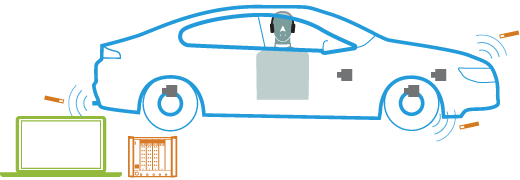
Source path contribution
Identifying the sources of the vibroacoustic emissions that we both hear and feel is essential to creating comfortable vehicles. The source path contribution solution from HBK covers both interior NVH and exterior noise.
In today’s competitive automotive industry, it is crucial to quickly and accurately evaluate the noise and vibration perceived. Meeting the regulations and improving the experience requires knowing more than just the levels and perceptions people encounter. It is important to know the contributions of the different sources in detail to find the right source of vibroacoustic phenomena. And to mitigate the paths that vibroacoustic energy takes to people, it is crucial to understand how it travels through the structure and through the air.
Source Path Contribution and Time Domain
Is it the source that is too loud, or the path that transmits it too easily? Many technical questions arise when refining development vehicles. Source Path Contribution (SPC) analysis, or transfer path analysis, is a technique for evaluating noise contributions from suspected sound or vibration sources through various acoustic or vibroacoustic paths to a desired receiver location.
With SPC analysis, it is possible to categorize the effects perceived by the observer (receiver) as airborne or structure-borne, and drill progressively deeper into their origins, tracing them back to their source, such as a specific engine mount. Dominant sources with respect to a given receiver can be highlighted to help focus engineering effort where it has the greatest impact. This helps automotive engineers and managers improve their engineering decision-making process and enables parallel evaluation of design alternatives and product variants throughout the vehicle development process.
For effective SPC on vehicles, it is important to analyse transient events, such as run-ups and run-downs and play back modified signals to simulate design changes. Time-domain SPC software allows listening and modification of noise source strengths or path sensitivities to set target levels for individual component sources or transfer paths. Time-domain SPC data can also be transferred to an NVH Simulator model for virtual drive assessments.
While SPC methods are often used for interior cabin noise analysis, with sources and paths being both acoustic and vibratory, they can also be used for analysing vehicle pass-by noise using an indoor pass-by setup. In some cases, the operating measurements can be combined, for example, measuring with a Head and Torso Simulator (HATS) binaural microphone inside the vehicle whilst also measuring with an indoor pass-by microphone array.
Source Path Contribution for Vehicle Exterior Noise
The BK Connect® Pass-by SPC solution is specially designed for analysing vehicle exterior noise (pass-by noise) using measurements on a chassis dynamometer in a hemi-anechoic chamber.
BK Connect’s unique SPC methodology explicitly calculates source contributions, which enables model validation by comparing the sum of the contributions to the original measurement. The better the match, the more confidence in the results and their downstream use for design optimization or developing solutions to noise problems.
System Setup
For pass-by SPC, indicator microphones are included around each source for the operating measurements. These, in combination with acoustic transfer functions (ATFs) measured using a volume velocity source (VVS), allow operating source strengths to be determined for each individual source. The source contributions are then evaluated and processed at each pass-by array microphone in the same way as in a standard indoor pass-by test. This creates a pass-by noise simulation with contributions from each source. The overall SPC result is validated using the standard pass-by result.
The BK Connect method includes component source modelling, where groups of sources represent individual physical components as independent sources. For example, each engine face, the intake orifice, and the exhaust orifice, may be modelled as individual component sources. Each component source then has an associated contribution to the total result.
RELATED PRODUCTS
- BK Connect Type 8441-D
- Surface Microphone Type 4949
- 20 kHz Array Microphone Type 4985
- 1/2" Free-field Microphone Type 4189-A-021
- LAN-XI Data Acqusition System
Source Path Contribution for Interior Sound and Vibration
The SPC system evaluates noise and vibration contributions for structure-generated phenomena using the mount stiffness or impedance matrix methods, and for airborne phenomena using the source substitution method.
Time-domain SPC enables the resulting noise contributions to be evaluated in the Insight 8601-S software using binaural playback while making real-time modifications of individual source strengths, or by modifying the noise paths in the frequency domain.
The Insight software can act as a bridge to CAE models, combining test data and CAE output to produce hybrid models that highlight various design options. Such models can also be exported to the NVH Simulator for virtual drive assessments.
System Setup
A typical configuration consists of BK Connect data acquisition software with SPC viewer (7798-A), Time domain SPC (7798-E), Insight 8601-S software and LAN-XI data acquisition hardware. Use Insight to experience the results of experimental, hybrid or purely analytical CAE-based SPC data through interactive playback and analysis of the results.
We also highly recommended high quality binaural sound playback hardware for which we can provide advice. Accelerometers, microphones, hammers, etc., are also needed for the input data to SPC. It works with data acquired by BK Connect/LAN-XI data acquisition systems as well as most other data acquisition systems and most CAE solutions.
Related Products:

